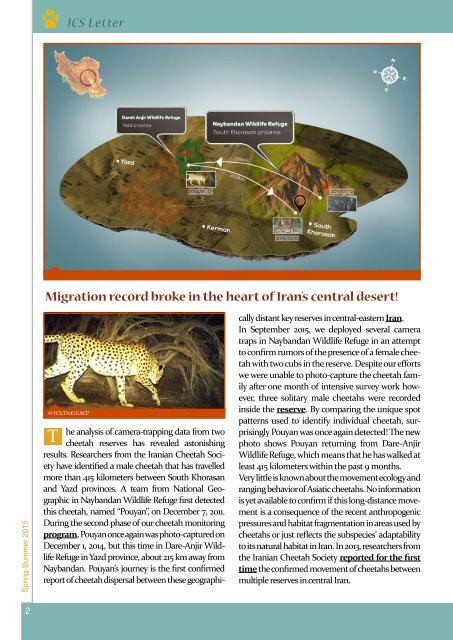ICS Letter
NewsletterICS
NewsletterICS
You also want an ePaper? Increase the reach of your titles
YUMPU automatically turns print PDFs into web optimized ePapers that Google loves.
<strong>ICS</strong> <strong>Letter</strong><br />
Migration record broke in the heart of Iran’s central desert!<br />
Spring-Summer 2015<br />
© <strong>ICS</strong>/DoE/CACP<br />
T<br />
he analysis of camera-trapping data from two<br />
cheetah reserves has revealed astonishing<br />
results. Researchers from the Iranian Cheetah Society<br />
have identified a male cheetah that has travelled<br />
more than 415 kilometers between South Khorasan<br />
and Yazd provinces. A team from National Geographic<br />
in Naybandan Wildlife Refuge first detected<br />
this cheetah, named “Pouyan”, on December 7, 2011.<br />
During the second phase of our cheetah monitoring<br />
program, Pouyan once again was photo-captured on<br />
December 1, 2014, but this time in Dare-Anjir Wildlife<br />
Refuge in Yazd province, about 215 km away from<br />
Naybandan. Pouyan’s journey is the first confirmed<br />
report of cheetah dispersal between these geographically<br />
distant key reserves in central-eastern Iran.<br />
In September 2015, we deployed several camera<br />
traps in Naybandan Wildlife Refuge in an attempt<br />
to confirm rumors of the presence of a female cheetah<br />
with two cubs in the reserve. Despite our efforts<br />
we were unable to photo-capture the cheetah family<br />
after one month of intensive survey work however,<br />
three solitary male cheetahs were recorded<br />
inside the reserve. By comparing the unique spot<br />
patterns used to identify individual cheetah, surprisingly<br />
Pouyan was once again detected! The new<br />
photo shows Pouyan returning from Dare-Anjir<br />
Wildlife Refuge, which means that he has walked at<br />
least 415 kilometers within the past 9 months.<br />
Very little is known about the movement ecology and<br />
ranging behavior of Asiatic cheetahs. No information<br />
is yet available to confirm if this long-distance movement<br />
is a consequence of the recent anthropogenic<br />
pressures and habitat fragmentation in areas used by<br />
cheetahs or just reflects the subspecies’ adaptability<br />
to its natural habitat in Iran. In 2013, researchers from<br />
the Iranian Cheetah Society reported for the first<br />
time the confirmed movement of cheetahs between<br />
multiple reserves in central Iran.<br />
2


